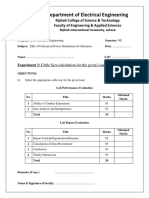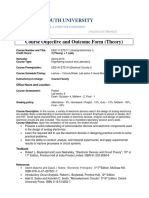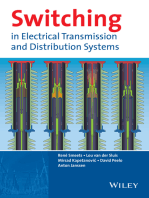Experiment 08
Experiment 08
Uploaded by
ehtishamCopyright:
Available Formats
Experiment 08
Experiment 08
Uploaded by
ehtishamOriginal Description:
Copyright
Available Formats
Share this document
Did you find this document useful?
Is this content inappropriate?
Copyright:
Available Formats
Experiment 08
Experiment 08
Uploaded by
ehtishamCopyright:
Available Formats
Department of Electrical Engineering
Riphah College of Science and Technology
Faculty of Engineering and Applied Sciences
Riphah International University, Lahore
Program: BS Electrical Engineering Semester: VII
Subject: EE- 405 Power Electronics Date: …………………
Name: …………………………………………. SAP: ………………….
Experiment No 08:
8 Single Phase Full Wave uncontrolled rectifier using Power Diode
OBJECTIVE:
(i) To study Single Phase Full Wave uncontrolled rectifier using Power
Diode
Lab Performance Evaluation
No. Title Marks Obtained
Marks
1 Ability to Conduct Experiment 05
2 Data Evaluation and Report 05
Total 10
Lab Report Evaluation
No. Title Marks Obtained
Marks
1 Organization/Structure 05
2 Data Presentation and Calculations 05
Total 10
Remarks (if any): ………………………………
Name and Signature of Faculty: …………………………………………….
Experiment 08
Single-phase full wave uncontrolled rectifiers using power diodes
Objective:
To study single-phase full wave uncontrolled rectifiers using power diodes.
Apparatus:
• Function Generator
• Load resistance 1K
• Diodes IN4001
• DMM
• Oscilloscope
Theory:
A rectifier is an electrical device that converts alternating current (AC) to direct current
(DC), a process known as rectification. Rectifiers have many uses including as components of
power supplies and as detectors of radio signals. Rectifiers may be made of solid state diodes,
vacuum tube diodes, mercury arc valves, and other components.
In half wave rectification, either the positive or negative half of the AC wave is passed,
while the other half is blocked. Because only one half of the input waveform reaches the
output, it is very inefficient if used for power transfer.
A full-wave rectifier converts the whole of the input waveform to one of constant
polarity (positive or negative) at its output. Full-wave rectification converts both polarities of
the input waveform to DC (direct current) and is more efficient.
Procedure:
1. First, make the circuit diagram.
2. According to the diagram make a bridge cut using 4 diodes on the breadboard
3. Connect Load across 2 ends of the bridge and at the other end.
4. On the supply (200v/50Hz) and connect the oscilloscope across load. Find out the Peak
value using the oscilloscope.
5. Calculate the average dc voltage. Also find VAC (average) using a DMM (Digital
multimeter).
6. Both values (calculated and observed) are approximately equal
Diagram:
Figure 1: Single phase full wave uncontrolled rectifier
Waveform:
Figure 2: Input / Output waveforms of full wave rectifier
Simulation Task:
Implement the above circuit diagram shown in figure 1 in multisim.
(a) Find the average DC voltage and Vpeak voltage at output at firing angle=0.
(b) Attach the output waveform and multisim circuit diagram.
Formula: Average voltage, Vdc= 2Vp/pi where Vp is the peak voltage which can be calculated
from the output form using voltage probe.
Conclusion:
-------------------------------------------------------------------------------------------------------------------------------
-------------------------------------------------------------------------------------------------------------------------------
-------------------------------------------------------------------------------------------------------------------------------
-------------------------------------------------------------------------------------------------------------------------------
-------------------------------------------------------------------------------------------------------------------------------
-------------------------------------------------------------------------------------------------------------------------------
You might also like
- BEE Complete Manual (EC102)Document48 pagesBEE Complete Manual (EC102)Vinit VikasNo ratings yet
- RENR8077RENR8077 - 01 - SIS Emcp 2 + PDFDocument4 pagesRENR8077RENR8077 - 01 - SIS Emcp 2 + PDFsayeed younis sadaat100% (1)
- Department of Electrical Engineering: Riphah College of Science & Technology Faculty of Engineering & Applied SciencesDocument6 pagesDepartment of Electrical Engineering: Riphah College of Science & Technology Faculty of Engineering & Applied Sciencesallrounder fightNo ratings yet
- Yarn Manufacturing 2Document16 pagesYarn Manufacturing 2Muhammad Farooq Kokab60% (5)
- Experiment - 5: What Is The Importance of Peak Inverse Voltage? AnsDocument5 pagesExperiment - 5: What Is The Importance of Peak Inverse Voltage? Anszohair ahmedNo ratings yet
- Salah Ud Din Lab 2Document4 pagesSalah Ud Din Lab 2Nouman HamzaNo ratings yet
- Ecd LR - 6Document6 pagesEcd LR - 6Faaran Ahmed Zaheer AhmedNo ratings yet
- Lab 9 Power Electronics by Syed Zahid AliDocument6 pagesLab 9 Power Electronics by Syed Zahid AliMuhammad HusnainNo ratings yet
- Lab 1 EdcDocument7 pagesLab 1 Edc231529No ratings yet
- Department of Electrical Engineering: Riphah College of Science & Technology Faculty of Engineering & Applied SciencesDocument8 pagesDepartment of Electrical Engineering: Riphah College of Science & Technology Faculty of Engineering & Applied SciencesAafaqIqbalNo ratings yet
- Air University:: M. Hamza Amin 191862 To Observe The Behavior of A Full Wave Bridge RectifierDocument8 pagesAir University:: M. Hamza Amin 191862 To Observe The Behavior of A Full Wave Bridge RectifierMuhammad Hamza AminNo ratings yet
- College of Engineering: Laboratory ManualDocument44 pagesCollege of Engineering: Laboratory ManualHafsa Alhaddabi100% (1)
- Lab2 Shanawar - 214241Document7 pagesLab2 Shanawar - 214241Shanawar AliNo ratings yet
- Single Phase Full Bridge InverterDocument11 pagesSingle Phase Full Bridge Inverterchsaad331No ratings yet
- Basic Electronics SyllabusDocument4 pagesBasic Electronics Syllabushimanshu.joshiNo ratings yet
- ECD Lab 09 - Log and Antilog AmpsDocument4 pagesECD Lab 09 - Log and Antilog AmpsSyed WasiNo ratings yet
- Lab 05 Mian Sayaf Ali ShahDocument9 pagesLab 05 Mian Sayaf Ali Shahsayaf khanNo ratings yet
- Experiment - 5: Full Wave Rectifier Pre - Lab QuestionsDocument7 pagesExperiment - 5: Full Wave Rectifier Pre - Lab Questionsgautam KrishnaNo ratings yet
- Experiment - 4 Half Wave Rectifier Pre - Lab QuestionsDocument8 pagesExperiment - 4 Half Wave Rectifier Pre - Lab Questionsgautam KrishnaNo ratings yet
- Pe Lab 11-200708Document15 pagesPe Lab 11-200708Omar JanjuaNo ratings yet
- ProjectDocument6 pagesProjectMuhammad AbdullahNo ratings yet
- Experiment No. 10: Single Phase Ac ControllerDocument9 pagesExperiment No. 10: Single Phase Ac ControllerMD.Minhazul Islam ShazedNo ratings yet
- Department of Electrical Engineering: The University of Faisalabad, FaisalabadDocument6 pagesDepartment of Electrical Engineering: The University of Faisalabad, FaisalabadThe Youtube TrainNo ratings yet
- EEE 101L Lab ManualDocument40 pagesEEE 101L Lab ManualAzizNo ratings yet
- Lab 5-SuperpostionDocument10 pagesLab 5-SuperpostionNabeel AhmedNo ratings yet
- Circuit Analysis (Osilloscope Assingment)Document14 pagesCircuit Analysis (Osilloscope Assingment)aliyaxme44No ratings yet
- Pe Lab 10-200708Document15 pagesPe Lab 10-200708Omar JanjuaNo ratings yet
- Experiment 2Document18 pagesExperiment 2cosix39379No ratings yet
- 10 ECL-331 - CompressedDocument72 pages10 ECL-331 - CompressedAthul SNo ratings yet
- Lca Lab 11Document6 pagesLca Lab 11The Youtube TrainNo ratings yet
- Ae - Lab 6Document6 pagesAe - Lab 6Usman KhalilNo ratings yet
- Edc Lab-1 Manual-2Document91 pagesEdc Lab-1 Manual-2Ashish SharmaNo ratings yet
- Experiment No. 06: STEP UP CONVERTERDocument7 pagesExperiment No. 06: STEP UP CONVERTERMD.Minhazul Islam ShazedNo ratings yet
- ECD Lab 6Document8 pagesECD Lab 6Maisam AliNo ratings yet
- 3rd SEM SYLLABUS..Document24 pages3rd SEM SYLLABUS..FacebookNo ratings yet
- Experiment No. 03: Single Phase Half & Full-Wave Controlled RectifierDocument6 pagesExperiment No. 03: Single Phase Half & Full-Wave Controlled RectifierMD.Minhazul Islam ShazedNo ratings yet
- Introduction To Electronics, Familiarization With Basic Electronic Components and Measuring Instruments.Document46 pagesIntroduction To Electronics, Familiarization With Basic Electronic Components and Measuring Instruments.Aditya MittalNo ratings yet
- EEE111 Lab ManualDocument43 pagesEEE111 Lab ManualManas50% (2)
- Power Electronics Open Ended Lab - 2022Document7 pagesPower Electronics Open Ended Lab - 2022Hassan AliNo ratings yet
- Scs ManualDocument83 pagesScs ManualSandali SinghNo ratings yet
- Course Title: Power Electronics Course Code: ELEC304 Credit Units: 5 Level: UGDocument3 pagesCourse Title: Power Electronics Course Code: ELEC304 Credit Units: 5 Level: UGShivansh BhardwajNo ratings yet
- Lab5-Lab-Report 1Document9 pagesLab5-Lab-Report 1Yama AsEelNo ratings yet
- ECD Labs 2 Modified 22TL ECDDocument58 pagesECD Labs 2 Modified 22TL ECDAnjaliNo ratings yet
- Experiment 9 of EEL - 3122 STDocument3 pagesExperiment 9 of EEL - 3122 STmunaamahmad222No ratings yet
- Sylllabus of 4th Semester - 25062022Document26 pagesSylllabus of 4th Semester - 25062022Suman GhoshNo ratings yet
- MSE353 Lecture Notes 1 (Updated)Document30 pagesMSE353 Lecture Notes 1 (Updated)GoongumpsNo ratings yet
- EEL203-Analog Electronics LabDocument3 pagesEEL203-Analog Electronics LabAthira SivanandhanNo ratings yet
- PS LabDocument2 pagesPS LabRamish HashmiNo ratings yet
- Department of Electrical Engineering: Riphah College of Science & Technology Faculty of Engineering & Applied SciencesDocument1 pageDepartment of Electrical Engineering: Riphah College of Science & Technology Faculty of Engineering & Applied SciencesZain MohalNo ratings yet
- New SyllabusDocument4 pagesNew SyllabusBB MukherjeeNo ratings yet
- Experiment No. 01: SINGLE PHASE HALF & FULL-WAVE Uncontrolled RectifierDocument5 pagesExperiment No. 01: SINGLE PHASE HALF & FULL-WAVE Uncontrolled RectifierMD.Minhazul Islam ShazedNo ratings yet
- Electronics Circuit Design Lab ManualsDocument71 pagesElectronics Circuit Design Lab ManualsTalha WaqarNo ratings yet
- Lab 7 (M&I)Document3 pagesLab 7 (M&I)Muhammad HusnainNo ratings yet
- Lab Report 4Document8 pagesLab Report 4Yohannes AlemayehuNo ratings yet
- Lab 5 EdcDocument7 pagesLab 5 Edc231529No ratings yet
- 18eln mergedPDFdocs PDFDocument125 pages18eln mergedPDFdocs PDFsuhas kumarNo ratings yet
- SCS LAB Manual PDFDocument81 pagesSCS LAB Manual PDFR Sai Sujith ReddyNo ratings yet
- Experiment No. 01: Single Phase Half Wave Rectification With Inductive Load Psychomotor Skill Level: P4 Name: Roll NoDocument8 pagesExperiment No. 01: Single Phase Half Wave Rectification With Inductive Load Psychomotor Skill Level: P4 Name: Roll NoRana EhsanNo ratings yet
- A Geek Girl's Guide to Electronics and the Internet of ThingsFrom EverandA Geek Girl's Guide to Electronics and the Internet of ThingsNo ratings yet
- Handbook of Microwave Component Measurements: with Advanced VNA TechniquesFrom EverandHandbook of Microwave Component Measurements: with Advanced VNA TechniquesRating: 4 out of 5 stars4/5 (1)
- Arduino Measurements in Science: Advanced Techniques and Data ProjectsFrom EverandArduino Measurements in Science: Advanced Techniques and Data ProjectsNo ratings yet
- Unit 3 - Steam NozzlesDocument27 pagesUnit 3 - Steam NozzlesMad MaxNo ratings yet
- Performance of Halbach Magnetized Brushless Ac Motors PDFDocument3 pagesPerformance of Halbach Magnetized Brushless Ac Motors PDFDaniel PisauNo ratings yet
- PS2 ProblemsDocument13 pagesPS2 ProblemsJared AlexandrianNo ratings yet
- Iteh Standard Preview (Standards - Iteh.ai) : SIST EN 837-1:1997 Slovenski StandardDocument13 pagesIteh Standard Preview (Standards - Iteh.ai) : SIST EN 837-1:1997 Slovenski StandardJAMSHIL.T JjNo ratings yet
- Power System Operation and Control - Unit-3 PDFDocument14 pagesPower System Operation and Control - Unit-3 PDFvikram vaidyanathanNo ratings yet
- Orbiting Multi-Rotor Homopolar System: Institute For High Temperatures, Russian Academy of Science, Izhorskaya 13Document7 pagesOrbiting Multi-Rotor Homopolar System: Institute For High Temperatures, Russian Academy of Science, Izhorskaya 13Dan BeesonNo ratings yet
- Propeller Power CalculatorDocument7 pagesPropeller Power Calculatormimi_chan_17No ratings yet
- Idoc - Pub - Work Energy and Power WorksheetDocument6 pagesIdoc - Pub - Work Energy and Power WorksheetRatna PuspitasariNo ratings yet
- Modelling and Simulation of The Fuel CellBattery Hybrid Electric Vehicle Drive TrainDocument14 pagesModelling and Simulation of The Fuel CellBattery Hybrid Electric Vehicle Drive TrainInternational Journal of Innovative Science and Research TechnologyNo ratings yet
- Dc/Ac Bridges: Reporter: Jevan Ayco CalaqueDocument12 pagesDc/Ac Bridges: Reporter: Jevan Ayco CalaqueJevan A. CalaqueNo ratings yet
- GPA TP-12 - Liquid Densities of Ethane - Propane MixturesDocument104 pagesGPA TP-12 - Liquid Densities of Ethane - Propane Mixturesheberth simancasNo ratings yet
- Physics Lab Manual PDFDocument45 pagesPhysics Lab Manual PDFKRSHNAPRIYA KNo ratings yet
- Electrical MethodsDocument51 pagesElectrical MethodsabcccNo ratings yet
- Data Sheet: Three Phase Induction Motor - Squirrel CageDocument3 pagesData Sheet: Three Phase Induction Motor - Squirrel CageKamil KościelakNo ratings yet
- 1624 4495 1 PBDocument9 pages1624 4495 1 PBKaramNo ratings yet
- Air Starter Physical Data BreakdownDocument2 pagesAir Starter Physical Data BreakdownAlejandro SanabriaNo ratings yet
- Certikin Gas HeaterDocument2 pagesCertikin Gas HeaterRAKESH REDDYNo ratings yet
- Scalar, Vector, MatrixDocument3 pagesScalar, Vector, MatrixMarc EdwardsNo ratings yet
- Lab 9Document3 pagesLab 9pollywannaquackerNo ratings yet
- Is.10278.2009 Two Wheeler Max. SpeedDocument11 pagesIs.10278.2009 Two Wheeler Max. SpeedGurkaranNo ratings yet
- Voltmeter Ammeter MethodDocument12 pagesVoltmeter Ammeter MethodMoh'd M. GharbiehNo ratings yet
- Mass and WeightDocument29 pagesMass and WeightVinay KorekarNo ratings yet
- AIWA CTV tvf2400Document37 pagesAIWA CTV tvf2400Antonio Rivera Mabini Jr.No ratings yet
- C2 - Condensatoare CeramiceDocument8 pagesC2 - Condensatoare CeramiceSneezy DwarfNo ratings yet
- PHYSICS REVIEWER 1st ACHIEVEMENT TESTDocument1 pagePHYSICS REVIEWER 1st ACHIEVEMENT TESTRhanessa Banacia NordanNo ratings yet
- Problem Set Heat Transfer 2Document2 pagesProblem Set Heat Transfer 2John Raymart RaferNo ratings yet
- Week6 General Physics Module 6Document30 pagesWeek6 General Physics Module 6Kristine VirgulaNo ratings yet
























































































